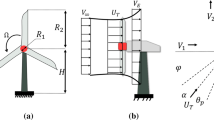Abstract
Horizontal-axis wind turbines (HAWT) have the constant rotor speed, while the blade tip speed changes continuously. This could reduce power performance of the wind turbine. In this paper, the accuracy of soft-computing technique was employed for aerodynamics performance prediction based on continuously variable-speed horizontal-axis wind turbine with optimal blades. The process, which simulates the \(\varphi\) (relative wind angle), BEP (blade element parameter), SP (solidity parameter), CPtot (total power coefficient), CPl (local power coefficient), and CT (local thrust coefficient), with adaptive neuro-fuzzy inference system (ANFIS) was constructed. The inputs were local speed ratios λr and different values of drag-to-lift ratio ε. The performance of proposed system is confirmed by the simulation results. The ANFIS results are compared with the experimental results using root-mean-square error and coefficient of determination and Pearson’s coefficient. The experimental results show that an improvement in predictive accuracy and capability of generalization can be achieved by the ANFIS approach. The effectiveness of the proposed strategies is verified based on the simulation results.



Similar content being viewed by others
References
Petković D, Nikolić V, Mitić VV, Kocić L (2017) Estimation of fractal representation of wind speed fluctuation by artificial neural network with different training algorothms. Flow Meas Instrum 54:172–176
Nikolić V, Mitić VV, Kocić L, Petković D (2017) Wind speed parameters sensitivity analysis based on fractals and neuro-fuzzy selection technique. Knowl Inf Syst 52(1):255–265
Petković D, Pavlović NT, Ćojbašić Ž (2016) Wind farm efficiency by adaptive neuro-fuzzy strategy. Int J Electr Power Energy Syst 81:215–221
Petković D, Ćojbašič Ž, Nikolić V (2013) Adaptive neuro-fuzzy approach for wind turbine power coefficient estimation. Renew Sustain Energy Rev 28:191–195
Petković D, Ab Hamid SH, Ćojbašić Ž, Pavlović NT (2014) Adapting project management method and ANFIS strategy for variables selection and analyzing wind turbine wake effect. Nat Hazards 74(2):463–475
Nikolić V, Sajjadi S, Petković D, Shamshirband S, Ćojbašić Ž, Por LY (2016) Design and state of art of innovative wind turbine systems. Renew Sustain Energy Rev 61:258–265
Abdelwaly M, El-Batsh H, Hanna MB (2019) Numerical study for the flow field and power augmentation in a horizontal axis wind turbine. Sustain Energy Technol Assess 31:245–253
Zhang S, Luo K, Yuan R, Wang Q, Wang J, Zhang L, Fan J (2018) Influences of operating parameters on the aerodynamics and aeroacoustics of a horizontal-axis wind turbine. Energy 160:597–611
Zhang Y, Deng S, Wang X (2019) RANS and DDES simulations of a horizontal-axis wind turbine under stalled flow condition using OpenFOAM. Energy 167:1155–1163
Govind B (2017) Increasing the operational capability of a horizontal axis wind turbine by its integration with a vertical axis wind turbine. Appl Energy 199:479–494
Farhan A, Hassanpour A, Burns A, Motlagh YG (2019) Numerical study of effect of winglet planform and airfoil on a horizontal axis wind turbine performance. Renew Energy 131:1255–1273
Wang Y, Li G, Shen S, Huang D, Zheng Z (2018) Influence of an off-surface small structure on the flow control effect of horizontal axis wind turbine at different relative inflow angles. Energy 160:101–121
Sedaghat A, Assad MEH, Gaith M (2014) Aerodynamics performance of continuously variable speed horizontal axis wind turbine with optimal blades. Energy 77:752–759
Zadeh LA (1996) Fuzzy logic, neural networks, and soft computing. Fuzzy sets, fuzzy logic, and fuzzy systems. World Scientific Publishing Co., River Edge, NJ, pp 775–782
Jang J-SR (1993) ANFIS: adaptive-network-based fuzzy inference system. IEEE Trans Syst Man Cybern 23(3):665–685
Buragohain M, Mahanta C (2008) A novel approach for ANFIS modelling based on full factorial design. Appl Soft Comput 8(1):609–625
Mullai P, Arulselvi S, Ngo HH, Sabarathinam PL (2011) Experiments and ANFIS modelling for the biodegradation of penicillin-G wastewater using anaerobic hybrid reactor. Bioresour Technol 102(9):5492–5497
Abdulshahed AM, Longstaff AP, Fletcher S (2015) The application of ANFIS prediction models for thermal error compensation on CNC machine tools. Appl Soft Comput 27:158–168
Gu ZQ, Oyadiji SO (2008) Application of MR damper in structural control using ANFIS method. Comput Struct 86(3–5):427–436
Singh M, Chandra A (2013) Real-time implementation of ANFIS control for renewable interfacing inverter in 3 P 4 W distribution network. IEEE Trans Ind Electron 60(1):121–128
Benini E, Toffolo A (2002) Optimal design of horizontal-axis wind turbines using blade-element theory and evolutionary computation. J Sol Energy Eng 124(4):357–363
Sugeno M, Kang GT (1988) Structure identification of fuzzy model. Fuzzy Sets Syst 28(1):15–33
Takagi T, Sugeno M (1985) Fuzzy identification of systems and its applications to modeling and control. IEEE Trans Syst Man Cybern 1:116–132
Author information
Authors and Affiliations
Corresponding author
Additional information
Publisher’s Note
Springer Nature remains neutral with regard to jurisdictional claims in published maps and institutional affiliations.
Rights and permissions
About this article
Cite this article
Jović, S. Prediction of aerodynamics performance of continuously variable-speed wind turbine by adaptive neuro-fuzzy methodology. Engineering with Computers 36, 597–602 (2020). https://doi.org/10.1007/s00366-019-00716-1
Received:
Accepted:
Published:
Issue Date:
DOI: https://doi.org/10.1007/s00366-019-00716-1




